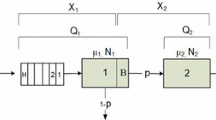Abstract
Inspired by a problem regarding cable access networks, we consider a two station tandem queue with Poisson arrivals. At station 1 we operate a gate mechanism, leading to batch arrivals at station 2. Upon arrival at station 1, customers join a queue in front of a gate. Whenever all customers present at the service area of station 1 have received service, the gate before as well as a gate behind the service facility open. Customers leave the service area and enter station 2 (as a batch), while all customers waiting at the gate in front of station 1 are admitted into the service area. For station 1 we analyse the batch size and the time between two successive gate openings, as well as waiting and sojourn times of individual customers for different service disciplines. For station 2, we investigate waiting times of batch customers, where we allow that service times may depend on the size of the batch and also on the interarrival time. In the analysis we use Wiener–Hopf factorization techniques for Markov modulated random walks.
Similar content being viewed by others
References
E. Arjas, On a fundamental identity in the theory of semi-Markov processes, Adv. in Appl. Probab. 4 (1972) 258–270.
E. Arjas, On the use of a fundamental identity in the theory of semi-Markov queues, Adv. in Appl. Probab. 4 (1972) 271–284.
K. Arndt, On the distribution of the supremum of a random walk on a Markov chain, in: Limit Theorems and Related Problems, ed. A.A. Borovkov (Optimizations Software, New York, 1984) pp. 253–267.
S. Asmussen, Applied Probability and Queues (Wiley, New York, 1987).
S. Asmussen, Aspects of matrix Wiener–Hopf factorization in applied probability, Math. Sci. 14 (1989) 101–116.
S. Asmussen and H. Hering, Branching Processes (Birkhäuser, Boston, 1983).
A.A. Borovkov, Stochastic Processes in Queueing Theory (Springer, New York, 1976).
O.J. Boxma and J.W. Cohen, The M/G/1 queue with permanent customers, IEEE J. Selected Areas Commun. 9 (1991) 179–184.
J.I. Capetanakis, Tree algorithms for packet broadcast channels, IEEE Trans. Inform. Theory 23 (1979) 505–515.
E. Çinlar, Queues with semi-Markov arrivals, J. Appl. Probab. 4 (1967) 365–379.
J.W. Cohen, On the optimal switching level for an M/G/1 queueing system, Stochastic Process. Appl. 4 (1976) 297–316.
D. Denteneer and V. Pronk, On the number of contenders in a contention tree, in: Proc. of 14th ITC Specialist Seminar, Girona, 2001, pp. 105–112.
J.H.A. de Smit, Explicit Wiener–Hopf factorizations for the analysis of multidimensional queues, in: Proc. of Internat. Sympos. on Semi-Markov Processes, ed. J. Janssen (Plenum, New York, 1986) pp. 293–309.
J.H.A. de Smit and G.J.K. Regterschot, A semi-Markov queue with exponential service times, in: Proc. of Internat. Sympos. on Semi-Markov Processes, ed. J. Janssen (Plenum, New York, 1986) pp. 369–382.
P. Flajolet and P. Mathys, Q-ary collision resolution algorithms in random-access systems with free or blocked channel access, IEEE Trans. Inform. Theory 31 (1985) 217–243.
A.J.E.M. Janssen and M.J.M. de Jong, Analysis of contention tree algorithms, IEEE Trans. Inform. Theory 46 (2000) 2163–2172.
F.P. Kelly, Mathematical modelling of the Internet, in: Mathematics Unlimited – 2001 and Beyond (Springer, Berlin, 2001) pp. 685–702.
J.O. Limb and D. Sala, A protocol for efficient transfer of data over hybrid fiber/coax systems, IEEE/ACM Trans. Networking 5 (1997) 872–881.
H.D. Miller, A convexity property in the theory of random variables defined on a finite Markov chain, Ann. Math. Statist. 33 (1961) 1260–1270.
H.D. Miller, A matrix factorization problem in the theory of random variables defined on a finite Markov chain, Proc. Cambridge Philos. Soc. 58 (1962) 268–285.
H.D. Miller, Absorption probabilities for sums of random variables defined on a finite Markov chain, Proc. Cambridge Philos. Soc. 58 (1962) 286–298.
L. Örmeci and J.A.C. Resing, Two tandem queueing models, Manuscript, Eindhoven University of Technology, Department of Mathematics and Computer Science (2000).
Z. Palmowski, S. Schlegel and O.J. Boxma, A tandem queue with a gate mechanism, EURANDOM Report 2 (2002).
N.U. Prabhu and L.C. Tang, Markov-modulated single-server queueing systems, J. Appl. Probab. A 31 (1994) 169–184.
E.L. Presman, Factorization methods and boundary problems for sums of random variables given on Markov chains, Math. USSR Izvestija 3 (1969) 815–852.
T. Rolski, H. Schmidli, V. Schmidt and J. Teugels, Stochastic Processes for Insurance and Finance (Wiley, New York, 1998).
H. Takagi, Queueing Analysis, Vol. 1 (North-Holland, Amsterdam, 1991).
B.S. Tsybakov and V.A. Mikhailov, Free synchronous packet access in a broadcast channel with feedback, Problems Inform. Transmission 14 (1978) 259–280.
Author information
Authors and Affiliations
Rights and permissions
About this article
Cite this article
Palmowski, Z., Schlegel, S. & Boxma, O. A Tandem Queue with a Gate Mechanism. Queueing Systems 43, 349–364 (2003). https://doi.org/10.1023/A:1023213914432
Issue Date:
DOI: https://doi.org/10.1023/A:1023213914432




